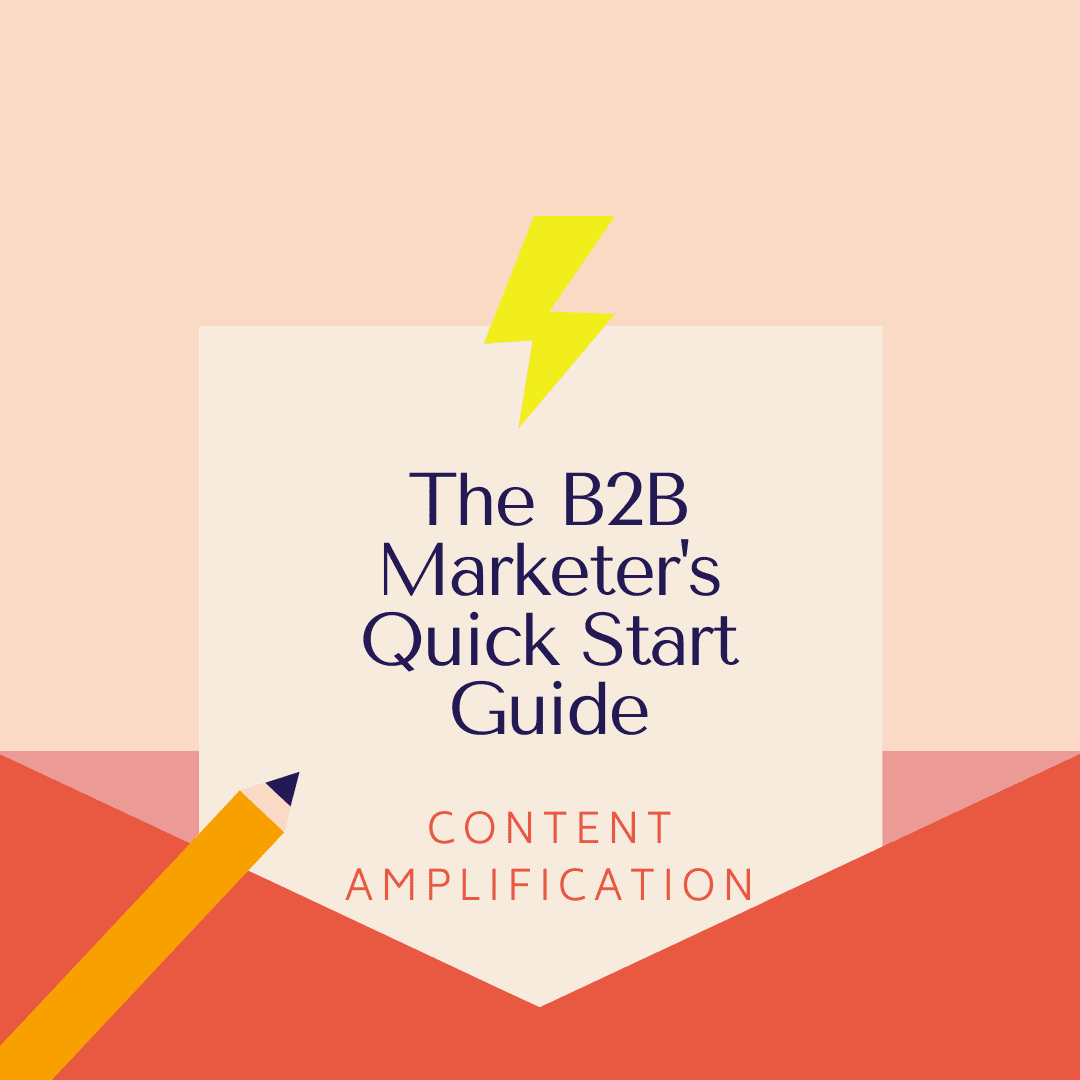The B2B Marketer’s Quick Start Guide: Content Amplification

By Brenna Lofquist, Senior Marketing Consultant at Heinz Marketing
In today’s digital technology landscape there are numerous platforms, tools and technologies at the disposal of every marketer—almost too many. My goal with the Quick Start Guide series is to provide you a quick synopsis of a martech solution category. For each category I’ll highlight a few platforms/tools, the pros and cons of each, benchmarks and additional resources. Without further ado…
Welcome to the fifth installment of The B2B Marketer’s Quick Start Guide. Today’s post is about Content Amplification. Check out the previous quick start guide posts on sales automation and direct mail platforms.
Overview
Content amplification is somewhat of a broad term. WordStream defines content amplification as the process of helping your content reach a significantly wider audience. They hit the nail on the head when they note that content amplification isn’t a single strategy or technique, it encompasses many techniques, strategies, and methods such as social media, influencer marketing, paid search, etc. – the list goes on! For this blog post, we’ll focus on content syndication platforms that promote your content to drive engagement and leads.
Content amplification is very important considering the amount of content published and pushed into the world every day. How do you cut through the noise and get through to your prospects? Marketers are having to get creative to do this and content amplification is a way to do so because of the different methods and strategies available. So lets get into it!
Content Amplification Platforms
Outbrain
- Features/functionality:
- Build awareness, educate and influence consumers in discovery mode
- Fuel lower funnel conversions: purchases, App downloads, video views, and more
- Get your content discovered to grow audience and improve web monetization
- Set campaign objective; Awareness, Traffic, App Installs or Conversions
- Target your audience using audience segmentation, location-based targeting, and platform targeting
- Advanced targeting options include: interest targeting, attribute targeting, and category targeting
- Reviews/rating:
- G2 Rating: 3.4 / 5
- Pros:
- Distribution network is great as it allows us to be more organic than traditional graphics advertising on a wide range of websites
- It connects you with high-quality places on the network so that you can get the appropriated audience for you
- Great response to the customer support
- Publishers provide a lot of quality traffic
- Cons:
- Not very appealing learning curve in comparison with other marketing tools
- Some technology is badly configured on the platform as the advertisements cannot be rotated equally to display the advertising performance in general
- The number of rules you need to adopt is considerably greater than in any other ad software
- Not a fan of their inability to bulk edit campaigns
Taboola
-
- Features/functionality:
- Solutions for high impact awareness, consideration, and conversions
- Awareness: share your message in brand-safe environments
- Consideration: find quality consumers at scale and nurture them throughout the buyer’s journey using precise targeting and retargeting
- Conversions: Grow sales using a performance-first platform including automated bidding, traffic management, and more
- Create audiences using campaign clickers, lookalikes, marketplace audiences, and website visitors
- Taboola Pixel allows measurement and optimization of campaigns, audience re-engagement, prevents lost conversions, and provides attribution
- Solutions for high impact awareness, consideration, and conversions
- Reviews/rating:
- G2 Rating: 2.8 / 5
- Pros:
- Easy to use and the user interface is fairly intuitive
- Ability to tap into some premium Native Ad traffic
- Retargeting works great – and you can create campaigns on 3rd party cookies
- Wide exposure for our clients across relevant sites, ability to A/B test title and images
- Cons:
- Some limitations that aren’t there with other vendors such as
- You can’t really run your ads on a whitelist of sites or only on sites within a certain vertical
- You can’t use bid adjustments
- Metrics don’t include things like time on page or other on-site engagement metrics
- Reporting is tedious
- Ad creation is really painful
- Some limitations that aren’t there with other vendors such as
- Features/functionality:
NetLine
-
- Features/functionality:
- Different service levels; Self-Service, Full-Service Management, or Advanced Solutions
- Incorporate buyer intent data against a suite of content-targeting and syndication solutions
- Develop an informed targeting approach that incorporates real intent from real, in-market professionals
- Leverage the only open bidding marketplace for B2B lead gen
- Tap into campaign optimization and real-time analytics
- Use the Audience Explorer for buyer engagement across the B2B web, the only real-time search tool
- Personalize content and confidently connect with in-market buyers
- Deploy true funnel-based content strategies that deliver measurable ROI
- Reviews/rating:
- G2 Rating: 4.6 / 5
- Pros:
- The team is responsive to our needs and is continuously “on the ball”
- The extensive reach of Netline helps me get to the right quality audience from one convenient platform
- Made it so easy to set up my campaigns as well as connect them through an API into our marketing automation platform
- Netline provides a tremendous amount of control over lead generation campaigns, far above what you could get from other DSPs or even LinkedIn Advertising
- Cons:
- A few times where Netline had difficulty fulfilling the lead quantity. However, in my experience they can generally fulfill their campaigns, and the quality of leads is never a question
- The UI could be a bit more intuitive but not a big deal
- I would love to see more lower-funnel programs where Netline further qualifies leads
- Features/functionality:
TechTarget
-
- Features/functionality:
- A number of solutions available including ones for Tech Marketing, ABM, Partner Marketing, Tech Sales, and Intent-driven Services
- Higher response rates and scores because leads come with recent and relevant purchase intent
- 100% of the leads received have opted-in
- Our recommendation engine promotes relevant content to prospects based on their interests and recent activity
- Embedded content ads promote additional resources precisely when a prospect is most engaged
- Our market experts work with you to identify content gaps, construct promotional plans and benchmark results
- Reviews/rating:
- G2 Rating: 4.3 / 5
- Pros:
- One of the biggest advantages of the platform is the contact-level intent data. It’s very helpful to be able to see what each lead is researching, as well as what the overall account is researching
- The CSMs you work with are very helpful and happy to jump on a call to talk through anything you need
- Target lists are easy to build and customize depending on your requirements
- Very knowledgeable in our area of business and helps us with developing scripts for our internal sales reps
- Cons:
- It was a little more difficult than expected to set up the Salesforce integration
- If your company has tight security standards, you won’t be able to integrate with HubSpot
- Some of the leads don’t match the criteria in place but we are allowed to exchange these, so it’s a minor inconvenience
- Entry points are somewhat generalized, would be awesome if they could develop more niche and specific entry points
- Features/functionality:
To Sum it All Up
As always I encourage you to check out these platforms for yourself, especially depending on the goals and objectives of your business. In some cases, these platforms have the power to do much more than content syndication. And I’m sure there’s a ton of other platforms out there so I’m interested to see if you have any you’d recommend or are there other content amplification strategies you like? Let me know!
Next up: ABM Orchestration






